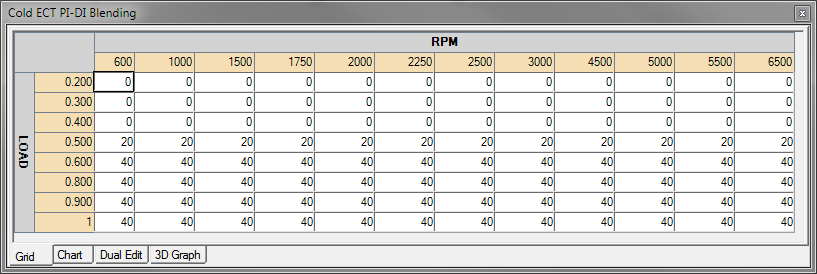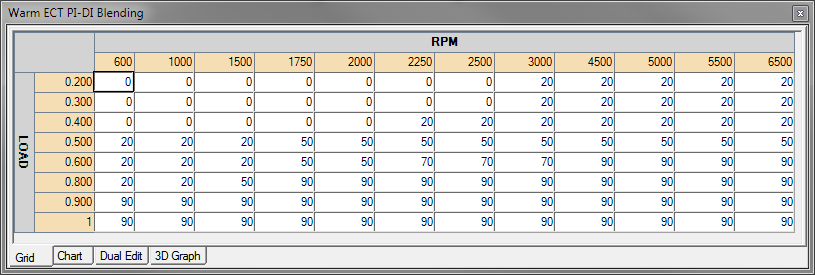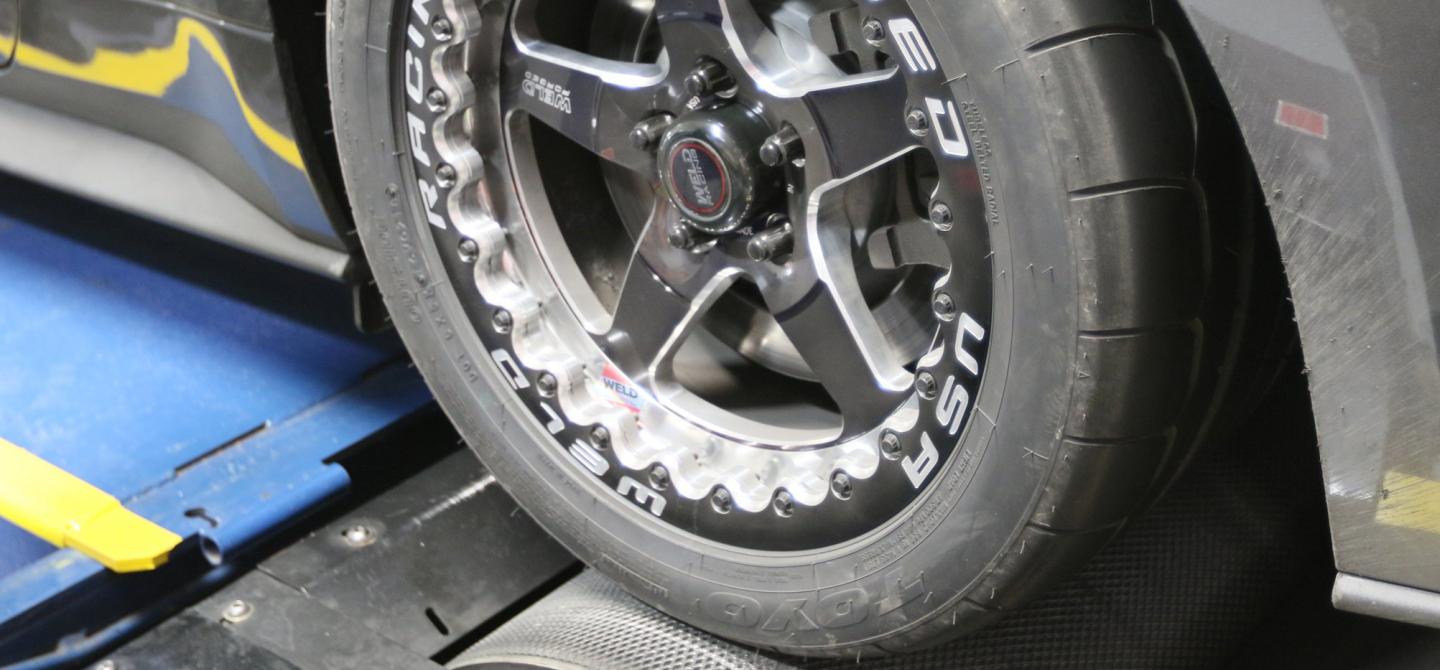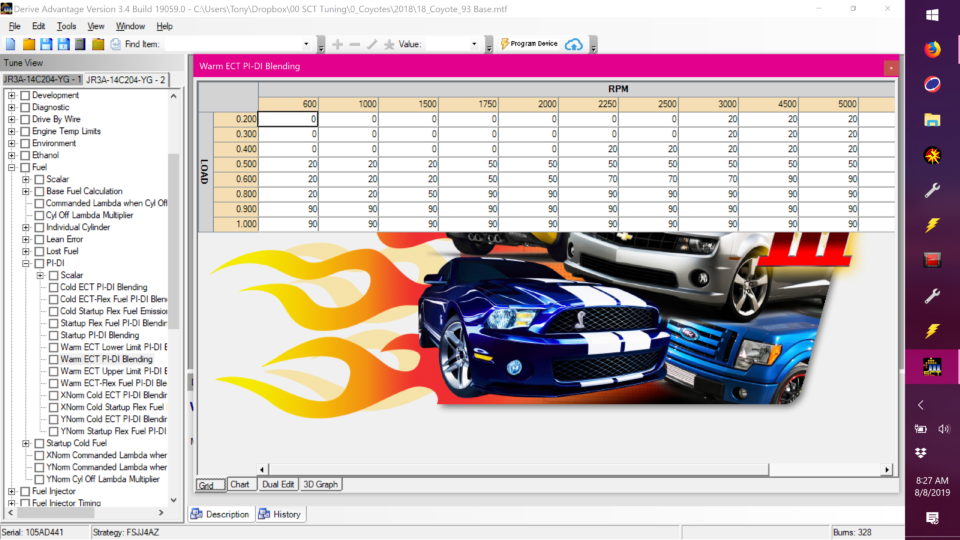Gen 3 Coyotes are effortlessly making gobs of power and it was high-time we started to explore exactly how fueling works on these cutting edge dual-fuel EFI systems. If you are not familiar, the term “dual-fuel” refers to the use of both port and direct injection. The Gen 3 Coyote, introduced for the 2018 model year, features this style fuel delivery. Rather than going whole-hog on gasoline direct injection (GDI), like some other manufacturers, Ford chose the middle path, which thankfully does not limit fuel delivery or suffer the other challenges of a pure DI system – yet still reaps the efficiency benefits.
Background
Calibrations Engineer Brett Lundquist at SCT warmed us up with some background on direct injection and Ford’s dual-fuel system. “Direct injection and port injection have advantages and disadvantages on their own. Port injection is cheaper and easier to develop, and overall easier to modify. It can also assist with cleaning the back side of the valves from blow-by and PCV oil vapors, however some fuel is lost due to evaporation and puddling in the port walls. With rising emission standards, port injection does begin to lose some of its luster. Fuel economy is usually less than a direct injection counterpart, and emissions are usually greater.”
“Direct injection allows fuel to be directly injected into the combustion chamber under very high pressures, similar to how diesel engines have operated for years,” Brett continued. “This allows more precise control of the volume, timing, and quantity of fuel. It also helps ‘mix’ the air-fuel combination in the combustion chamber. However, direct injection is not without its drawbacks. The system costs more to create, requiring more expensive parts, such as high-pressure direct injection injectors, and a high-pressure fuel pump, usually actuated by the camshaft and controlled by a valve or solenoid and oil pressure. High-pressure fuel pumps can be noisy, often ‘ticking’ a little like a diesel. It is said that fuel economy is better with direct injection, as well as emissions, especially during cold start scenarios.”
“Ford decided to combine both of these systems, the best of both worlds, and create a ‘dual-fuel’ system with both port and direct injection. The flexibility of this system is amazing, allowing for both to function in unison, and the two systems blend on demand, creating reduced emissions, improved fuel economy, and more power in the same breath.”

“Here we have some tables that are used in these new ‘dual-fuel’ applications,” Brett said. “This example comes from a 2018 Mustang 5.0L. The important thing to observe here is values of 100 are equal to 100% direct injection. If the value were 0, this would be 100% port injection, or in other words, no direct injection. This first table deals with Start-up PI-DI blending. The X-axis is Engine Coolant Temp during startup in degrees Celsius. The Y-axis represents the number of starting events while cranking. We can see that with very cold engine coolant temps, the value 40 populates the cells. This would indicate 40% direct injection fueling and 60% port injection fueling. As we move across, we can see that direct injection begins to take over the table and at warmer engine coolant temps, becomes the main start-up fueling method.”

“Immediately after start-up has occurred, our engine is now running. There are thresholds for ‘cold’ vs. ‘warm’ based on engine coolant temp, which determine which of the two tables below are used. Above 32°F, the warm table is used, and below the cold table is used. If the engine coolant temp is low enough, the PCM will use this table below until it reaches the engine coolant temp to move to the warm table. Again, the values represent the same blending percent. The value 20 represents 20% DI, and the remaining 80% is handled by the port injection. This time the table is defined by an X-axis with RPM, and the Y-axis with engine load.”

“The warm table comes into play after start-up has occurred, when our engine coolant temp is above 32°F. This is the main DI-PI table in this vehicle, and at operating temperature the PCM is using this table to determine blending demands. There are other thresholds and tables, not displayed here, that handle limits and even flex fuel blending ratio. As you can see, we have only just scratched the surface of this new control dynamic. Ford puts a lot of time into designing the control strategy these PCMs use to maximize both fuel economy and performance. Our job as calibrators is to find the hidden potential and unlock it for our customers to bring even more excitement to the driving experience.”
The Tuners’ Perspective
For the aftermarket tuning perspective, we turned to Tony Gonyon, a noted Ford EFI tuner at Tuners Inc. as well as an instructor at The Tuning School. Tony elaborated on how the system functions with increased power, transitioning from direct injection to port and vice versa to keep up with boost, for example.
How does the factory utilize port injection and direct injection? Is one just for idle?
Besides the emissions advantage of port injection at start-up, the intake valves stay clean from carbon buildup due to the fuel being sprayed across them at start-up. Once start-up is initiated, the clock is then activated and with coolant temperature rising, the direct injection begins to take over. This is a very smooth transition and is not noticeable at all unless you are datalogging it.
How does tuning a Gen 3 Coyote differ from the Gen 2?
Gen 3 Engines have both direct injection and port injection, which allows for better emissions control at start-up and throughout the powerband. The Gen 3’s improved intake allows breathing all the way to 7,500 rpm. This is why bolting a 2018 intake on earlier Coyotes is good for 25-horsepower in most instances.
Tuning these beasts is not much different than earlier Coyotes, even though there are differences in fuel management at start-up. Then, of course, the 10R80 transmission is the new choice to transfer all that power to the tires. This also brings new challenges to the tuning side of the house.
When you are tuning in SCT software, is this a percentage that you change? If so, when and how?
There is no advantage to change the percentages of direct injection to port injection when tuning the Mustang in a naturally aspirated setup. When using a Whipple or Roush supercharger, there are changes to the starting, warm, cold, and warm upper limits (coolant temperature) for the percentage of PI/DI. The lower rpms are adjusted slightly for more PI, but at the higher loads, the DI is adjusted to a higher percentage of use.
What are the limits of DI?
The limits of DI are based mainly on the fuel pump capability, as it is driven off of the camshaft and operates at over 3,000 psi. There are DI upgrade pumps that are available now through several companies that will extend the range of the DI. The low-pressure side which supplies the high-pressure pump is also in need of upgrade and usually a DW or FORE specific kit is used.
What are the benefits of it?
The benefits of PI/DI include lower emissions at start-up, and the added advantage of lower carbon buildup on the valves due to the PI fuel “washing” the valve as it passes into the chamber. The DI setup gets the win for better fuel control at wide-open throttle and part throttle loads, which results in better fuel economy and a smoother, longer life of pistons and cylinder walls, as the control of the fuel mixture is more precise.
Is the Gen 3 inhibited by having the two systems or just as capable as the Gen 2 in supporting big power?
The Gen 3 system has more capability and does not hinder the power except, as mentioned above, concerning fuel pump delivery capabilities. The Gen 3 has more compression, slightly bigger valves, cams, and intake assembly, and is capable of more power due to the PI/DI setup. Aftermarket fuel systems are a must on both in the end.
What happens when you max out the DI injectors? Are you able to supply enough fuel through the port injection to keep going?
You can change your PI/DI percentages to use a larger PI injector if you’re getting close to maxing out the DI injector. Again, the fuel pumps (high-pressure and low-pressure pumps) become the limitations, as in all Coyote PI or PI/DI applications. It should be noted that upgrading the PI injectors is a must when upgrading to a supercharger or turbo setup.



















